Text by Kristefan Minski
Introduction
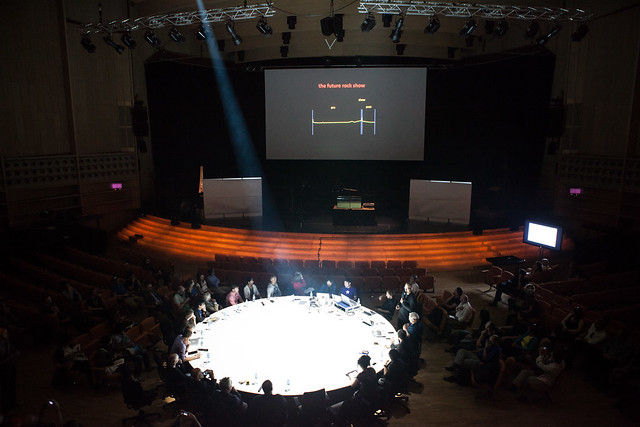
The Future Rock Show was introduced at the 2013 Ars Electronica Festival. It was an experimental approach for a new form of creative dialogue within the festival program. The project started as an initiative through the collaboration of Ars Electronica Futurelab and the US Band OK Go in their quest for the Future Rock Show. Both partners believe that the culmination of the Future Rock Show will be achieved through the convergence of many disciplines, art forms and technologies which is far beyond the scope of the musicians themselves. The Ars Electronica festival attracts a diverse group of highly skilled individuals and therefore promoted the perfect opportunity to explore this notion further.
The project was sponsored by Hakuhodo due to their interest in the broader topic of the Future Live and that such a conversation would certainly have relevance to many other forms in the pursuit of Future live happenings. The Rock Show provides a good foundation for this discussion because it embodies the very essence and emotion of Live Experience which most people can identify with. Furthermore, Hakuhodo was particularly interested in the newly proposed format and sees some great potential for such approaches to creative group dialogs. The Ars Electronica Futurelab conceptualized the proposed framework:
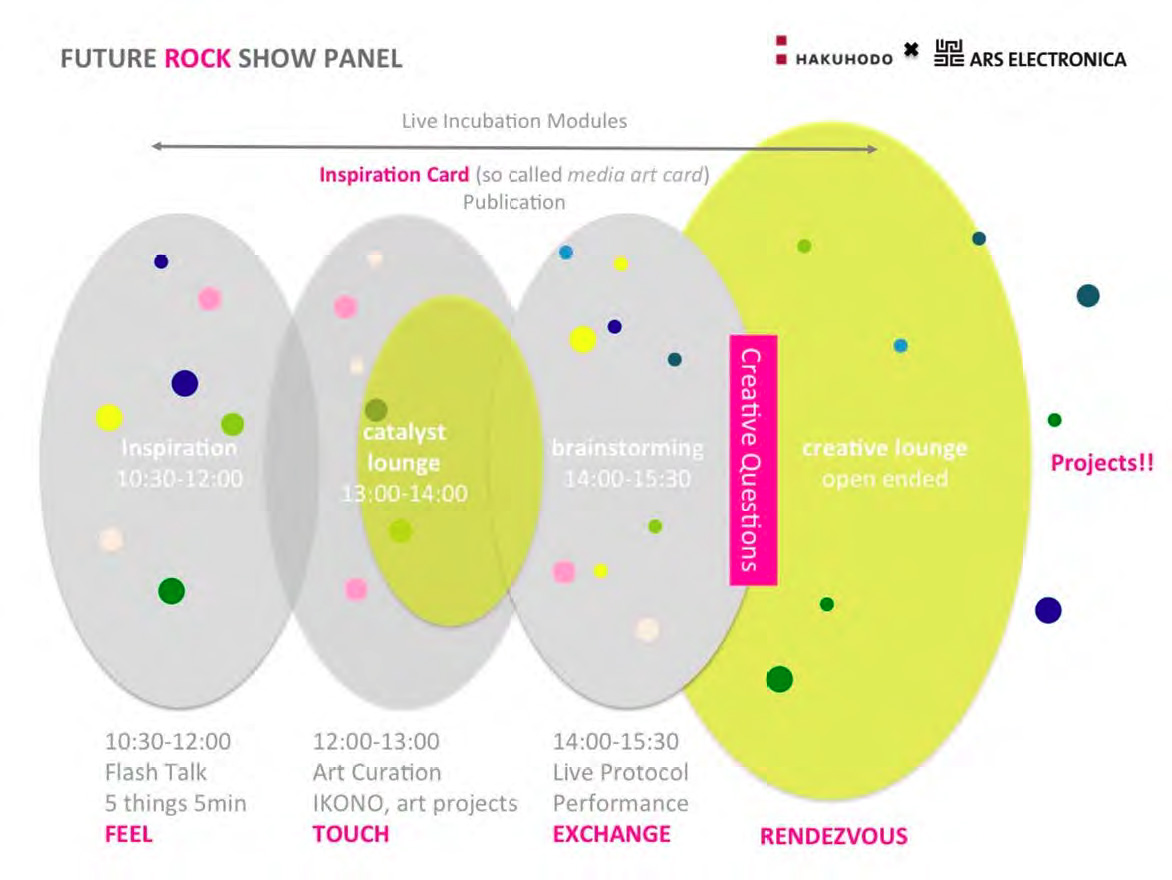
The event was divided into several sections with a view to create a mixture between a formal and informal setting. The idea was to explore the relationship between audience/presenter and industry/creatives by experimenting with the physical space, artistic curated interventions and live performance treatments.
THE FUTURE ROCK SHOW PART 1 – INSPIRATION
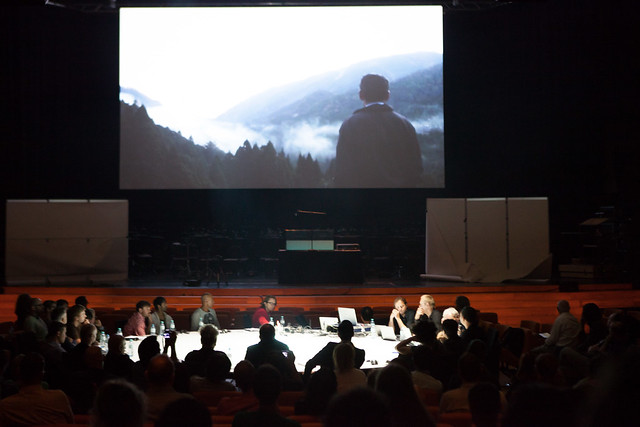
The inspirational session involved presentations from 17 experts with a variety of backgrounds such as media art, dance, activism, mathematics, architecture, acting, television, event production and of course rock and music. Each of the experts was given 5min to deliver their idea, vision, question or statement.
Ars Electronica Futurelab Director Horst Hörtner introduced and mediated the session. He proposed that an important consideration for the Future Rock Show is to look before and beyond the actual moment. From the time a ticket is purchased and all of the processes leading up, in between and even after the concert seem to be quite fertile grounds worthy of exploration. He also clearly established the Ars Electronica Futurelabs interest and applied practice in future entertainment with a short visual teaser of their world renowned ‘Spaxels’ endeavor.
Damian Kulash from OK Go then introduced the band and background. He described the success of their music videos as a result of rethinking the format itself and how the same approach could have an impact on the live concert as well. He talked about the desire to change the creative direction from what the band is doing with their instruments on stage and rather toward what you can do (and have fun) with 1000’s of people in a space. He then presented a brief overview of where the rock show has been, is now and posed the question of where it will be. A valuable perspective of the Live Rock show Experience was conveyed using Attention Flow models as a way of pinpointing 4 of the fundamental elements of the concert; performance, spectacle, human connection and group experience.
Taiwanese Artist Huang Yi presented a very personal view on his development as an artist and the positive influence that technology played. He spoke of his upbringing and the hardship that was faced by his poor parents. Nevertheless they worked very hard to provide him with the tools for education and the most significant being his first computer which gave him access to the internet. His work hides the struggle and hardship he faced through life and instead he focuses on painting a very positive picture through the use of technology. As does his work, he reminds us of the intimate relationship some artists have with technology and how we can creatively treat this relationship.
Phase7 Artistic Director Sven Sören Beyer is already very familiar with experimenting, adapting and converging technologies into his productions. He gave an overview of the many diverse projects he has worked on since 1994. His particular interest is in what people (the audience) do when they are confronted with technology and also involving the Audience as part of the performance. The more recent productions utilize technology such as 3D Audio which allows sound events in new space and also redefining space whereby the audience interacts with virtual and real world environments.
Architect Peter Higgins from Land Design Studio UK gave an interesting insight into the process of place making with a focus on city context events, curation and facilitation. It started with the example of an event created by the rotation of the earth. He explored the notion of cities which are treated as events that require narratives from and for its citizens. There was also a focus on festivals and the importance for a city. Also, the role of the curator which is often much more than curation alone, as is the case with the Ars Electronica. He further described other city contextualized themes such as theatre city, media city, art city, popup city, secret city and streamed city. All of which promoted the idea to think far outside the context of the maker and producers themselves and the need to engage with many other factions (political, financial, civil…) in order to realize such significant happenings.
Daito Manabe is an artist, programmer, designer, DJ, VJ, composer and has made significant contributions toward technologically based music performance. For his presentations he gave 2 examples of his work which also typify the technologically progressive nature of the Japanese pop music culture. His work with the Pop Group Perfume promotes the use of audience (FAN) creativity through releasing 3D motion captured data of the band members dancing and allowing the public to make their own characters which perform to the perfume songs. He showed a number of examples which are symbolic of the new wave in audience self-driven pop music production.
As experimental percussionist, composer, sound artist and one of the founding members of Einstürzende Neubauten, FM Einheit is an integral part of industrial music and culture. His presentation started and ended on the subject of digging a hole. He explained that he is not ever really thinking about the future as he is very much focused with his work in the moment. However, he said to think about it reminded him to what is the most special part of his performance which is the magic moment that happens when the energy of audience and performer connect and a new power is merged out of that. He gave some classic examples from his performance history where the audience took over and became the musical performance and essentially made their own concert. He finished by saying that future rock musicians need to be an ecologist and dig a hole which could be a metaphor for exploring the relationship between the organism and its environment or that we need to closer to the core.
Farooq Chaudhry is ranked among the leading producers of contemporary dance in Europe. His artistic focus is on innovated narratives through collaboration across intercultural and interdisciplinary practice. He spoke very intuitively about these topics and proposed that dance is a truly live medium that is relatively free from digital exploitation. Collaboration across mediums is paramount to his production success and he gave a very nice overview from a recent production titled Desh. He spoke further about the importance to recognize the value of ideas which maintain their truth and that in these productions each idea has its equal value regardless of the financial aspect. For Farooq the future of the Rock Show and other live mediums requires artists to acknowledge themselves as storytellers and that while technology provides great opportunities for artists we need to be careful not to become seduced by our cleverness.
Chris Müller is a creative director, art activist and producer. Among other things he studied transmedia space and has a particular interest in where the performance takes place. In a way the performance is irrelevant and what IS interesting is the stage or perhaps rather the reinvention of. It seems that he views the stage not as an architectural object but rather as a space defined for performance. What is important for him is in finding the stage rather than using a pre-existing. He gave several examples of his works which support these ideas such as a production where the top of a mountain was cut off and another whereby the warehouse becomes the stage without specific intervention.
Yuri Suzuki is an artist working largely with the medium of sound. He presented his works in the context of considering the concert in the full spectrum of sonic visual experience and the potential of further exploration to additional sensors like haptic or taste. He showed several projects of his such as fire visualization of sound waves, primitive analogue animation techniques combined with highly experimental electronic inventions, a sound taxi which cruised through the streets of London and also some of his work involving audience participation including a device which rides along a path where people can draw colour along which is then transferred into sound.
Hans Hoffer is the Director of the prestigious Max Reinhardt Institut. His presentation was his own poetic text delivered as a kind of speech performance, in his mother tongue of German. It was a journey beginning with a focus on time and moment with the assertion that in the right second the right word has significant impact. The next point was on language and the influence technology has toward global communication but also the effect it has on physical language such as gesture. He then alluded to the relevance of life cycles and that every event is taking place within the tension between life and death. In summary, Hans presented more of a philosophical position which reflects the importance of the performance and its relation to the context where it is embedded.
Kazuhiko Washio is a photographer, producer and has been the creative director for one of the world’s leading advertising agencies for over 15 years. He drew a contrast between live experience and traditional advertising and in particular the lack of risk taking in the latter. He suggested that this landscape is changing whereby modern advertising can be more experimental and also influential for the future live domain. His question is ‘Where is the venue for the live experience in the future?’. To explore this question he presented a very interesting video mix from a project he produced with 6 well know Japanese directors that were examining daily life through their medium. The video offers many considerations for the appreciation of one’s time and space.
Lewis Major and Aakash Odedra are dancers & choreographers who have been working with the Ars Electronica Futurelab over the past year to explore technology in their storytelling. Fundamentally they see themselves as storytellers and Dance is the medium. While they have achieved considerable success they find a challenge to extend beyond the narrow demographic of their audience and that’s one of the reasons they forged collaboration with the Futurelab. During the talk Aakash presented with a performance style to express the intimate nature the 2000 year old form he works with. He described the challenges of translating this intimate experience from a few to many people and also that technology has become a kind of global language which can be useful to overcome such challenges. He finished with a most poignant question of ‘How can we touch people without physically touching them?’.
As the Curator & Artistic Director of large events and festivals, Jonathan Parsons began his presentation very much focused on the audience space. He talked about the significance of the opening and made reference to the importance this aspect of an event has on the rest – it sets the tone. He discussed the many diverse approaches he has used for this including F1-11 fighter jets, a flying drag queen and robotic interventions. Then he discussed the relationship to the location which led to a further investigation on the topic of cultural underpinnings which belong to a particular time and space where the event will occur. A great example of this are the Australian indigenous welcome ceremonies which have become widely adopted into official event programs in Australia since being introduced in the lead up to the 2000 Sydney Olympics. Before running out of time, Jonathan was about to explain how this could relate to the touring Rock Band and perhaps the new ways to explore this relationship between the band and their audience as they move from city to city.
Ars Electronica Futurelab Key Researcher Hideaki Ogawa has produced several significant works in the spectrum of audience participation. The example he used was the ABC Klangwolke project which was finally presented during the 2012 Ars Electronica Festival. The project however, began several months earlier whereby the citizens of Linz were invited to build their own characters of the alphabet. During the building process the letters were implanted with a uniquely engineered FM transmitter controlled LED Kit. This allowed for the letters to be lit up with various modes which provided a kind of LED Letter lightscape across the city. Over 5000 letters were produced which was a significant achievement for an audience participation experiment. As Hideaki explained though, the most fascinating part of the process for him is how the audience combined their letters with other participants. The results were outstanding and it is this key research area of creative catalyst which Hideaki proposes could have enormous potential in the future of live experience.
Salvatore Vanasco is a literature academic, media artist, director, producer and has been active in experimental electronica fields for the last 3 decades. He began by discussing his early ambitions when experimenting with mass media and communication through various mediums and was particular interested in the concept of us and them. His works (or involvement in) were always driven more from the position of the ’them’ and the desired outcome most often driven by the wish to stimulate thought in society. He describes many years of research, practice and failure right up until the most recent production which also failed and therefore was a good result because he learns a lot. He sees correlations in the latest project, WIR SIND HIER, and what was mentioned during Horst’s introduction about the pre and post phase of the event. This production utilized a lot of this approach and he showed examples on the website which provided the platform for the participation.
THE FUTURE ROCK SHOW PART 2 – BRAINSTORMING
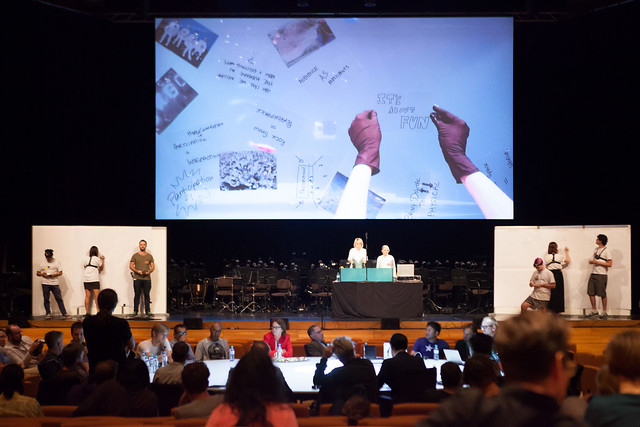
Although the session was titled Brainstorming, the intention was not at all to find answers or solve problems but rather to generate an interesting conversation and produce questions and statements. The idea was to really open up the frame of the discussion which would involve the audience and eventually to have several conversations happening at the same time. Simultaneously there was a live protocol performance which featured the Ars Electronica Futurelab ‘Liquid Log’ and several groups of roaming protocol writers who brought fresh texts to the pool.
The session was opened and mediated by Ars Electronica Artistic Director Gerfried Stocker. He immediately invited the audience to participate although it became apparent that this would take time and need some improvisation as the conversation continued. The first 30min was very much governed by the microphone and the questions of the mediator. Eventually, aided by co-mediators, the audience began to become more involved and also the invited participants were loosening to the free format which promoted a more interesting discussion. However it wasn’t until the last 30min when the PA was turned off that the initial goal was reached and there were several groups of conversations at the same time. Obviously the conversations became increasingly difficult to document, however the final protocolled outcome was quite comprehensive. The following is a condensed summary of the material:
A rock stage and a television are the same thing. 1 or a few talking to many. Real participation means many to many. It’s much more complicated.
Agency! Tension – unknown – precarious. The old did this and the new can too, how to do it right. The human element and the technology. The balancing of these things.
As an artist you ask yourself do you want anyone to interfere in your show? If so what kind of interfaces? The best are triggers that start something and then turn into something completely different.
Communication doesn’t change – just the format. How to structure the private experience with audience is the future rock show point. The ‘you and me’ special moment which can be shared to others. Eg. A performer with 1000 channels and a 1000 person audience with 1000 headsets. The audience could be the actors.
Distributed vs non-distributed performance. More often people at live events are looking at their phones than the event. Too busy to show they were there than actually being there.
Facebook cannot replace live for the lack of full spectrum sensoric. It cannot achieve – eg. when people sing together their heartbeats sync.
For me the moment when art works is when you feel it. It skips your brain and gets into your heart.
For musicians it’s still people up there playing, or more often than not its people pretending to play. So if we are going to pretend why not take all this incredible stuff that the people at this table are doing and bring it into that place of immense joy.
How do you keep the intimacy from a performance to an amplified number of people that don’t necessarily have to be in the room? What are the technologies and opportunities to make that happen?
Human beings are profound animals. The nature of measuring a cultural exchange being limited to like/dislike and the number of views and followers is a major concern.
If the stage (setting) doesn’t change then perhaps the performers will ie. Hatsune Miku. Maybe the performers are the ones becoming obsolete.
In regard to audience and performer it’s a bit like here. We (the audience) feel a bit intimidated by all these intelligent people on the table. Maybe if someone says something stupid it will help to break the barrier and therefore make it easier for us to participate.
Is facebook the woodstock of our time?
Is it so sure that the physical cannot be replaced sooner than we think? Is there a danger that we will be left over (dinosaurs) in our clubs and bars while the next generations do something completely different?
Is the physicality tied to the authenticity? Is it the means to the credibility?
Is there still a hunger for the moment of being there? The non-distributed experience of actually being there. The feeling that you were there and it’s irreplaceable still. You notice it when you really try to be there but you can’t so you can only deal with whatever else is available – ie. sell out events, Olympic games etc.
It seems there are many ‘I was there’ places (or opportunities). It seems the desires are the same but the need to experience them in both virtual and real becomes more recognisable
It’s about feeling the amplified emotion that you can get only in a group
It’s also a political issue. What does this output – stage, music, performance and associated technology do to create culture. What is the artists role? The position is changing with technology and participation. Ask what is the value of participation? Musicians just doing music, or being musicians is perhaps outdated.
It’s not missing – the joy of making things is chasing them into a place you haven’t yet been.
Look at audience as individuals not just groups but groups of individuals – networked individuals. Then you need tools to create context out of that. That’s a challenge.
Look into what has been the successful rock shows in the past and what were the social attitudes, trends of that time. Eg. Woodstock. What was happening at the time is connected to its success.
Our perception of physical space also defines what we create within it and the relationship we want with that space and the people (audience) that engage with it.
People are now much more aware of what is involved in the musical performance and with technology. It makes the magic moment harder to achieve. AKB48 is an interesting example that has achieved great success but the approach is completely different. People (audience) are much more involved in the selection process.
People tend to value their lives by the distributed experience and need the ‘badges’ of the non-distributed so they can show off
Perhaps we need to look at the past for formats which could be relevant to the future. Ie. John Cage 1950’s open works without endings. 1 thing is how you display art (or music) and the other is what it does.
Rock is a limited format and there is lots of potential to cross breed with other forms and produce totally new kinds of entertainment.
Slippage! Between 1 expected moment and another. Slippage between relationships and respective positions – ie. audience and performer. It’s always fleeting but perhaps the challenge is to make it happen more often.
Sometimes the virtual can be made more real than the real. Ie. Disabled people transferring movement through a secondary device. Extending the physical. Human made technologies as extensions to the body. Camera – eye, mic-ear, speaker – mouth.
Taking a very old idea and making it relevant today through technology is a very powerful thing and makes the creative pallete much bigger.
The advantage virtual performance space (ie. Metaverse) is you can realise performance architecture not possible in the real-world.
The audience doesn’t just need the performer and the performer the audience. The audience needs the audience. The sharing of collective energy is a fundamental human need.
The challenge for bringing technology in is how not to flatten the human communication
The feedback loop. The performer feeling the audience and vice versa. The performer gets outside themselves almost in a hyper individual way.
The majority of what we learn is due to sight and hearing however exploring a 4th dimension with touch, taste, smell may be very useful to overcome the threat of virtualisation.
The microphone turning whisper into a musical element invented crooning, the amplifier made rock shows possible. It’s always been a technological advance – the big Q is what can we do now with all these interesting exploding technologies?
There is a kind of addiction for humankind to newness. Trying (and having the experience) and then moving on. Failing doesn’t matter. Otherwise there is no progress.
Thinking about participation and cultural reflection. In Japanese culture – there is a market focus about reflection on daily life. Eg. Pop group by election. People have input. The essence is on realising the dream and how to save the daily life.
Traditionally music has always been participation. From existence of humankind music was collaborative. In the more recent times it became a more passive experience but perhaps its moving back to the more ancient context. It’s the human extinct to want to participate in music. People want to be empowered.
We are not limited to just the people with instruments on stage anymore and we can take everything we have learnt from all these other art forms and technology to make something new, exiting, magical, awesome…
What about the relationship to memory. Hence this festival. Isn’t it then more about recreating memory/experience and how social media can help with that. Undoubtedly it can/does.
Why all the fascination with Audience participation? What is the performer missing?
Why participation? Is it just because it’s cool at the moment? So many different forms, attempts and approaches. When does it actually work?
Why rock? Very limited genre? The formula is strict and needs to be widened for more audience participation possibilities.
SUMMARY / CONCLUSION
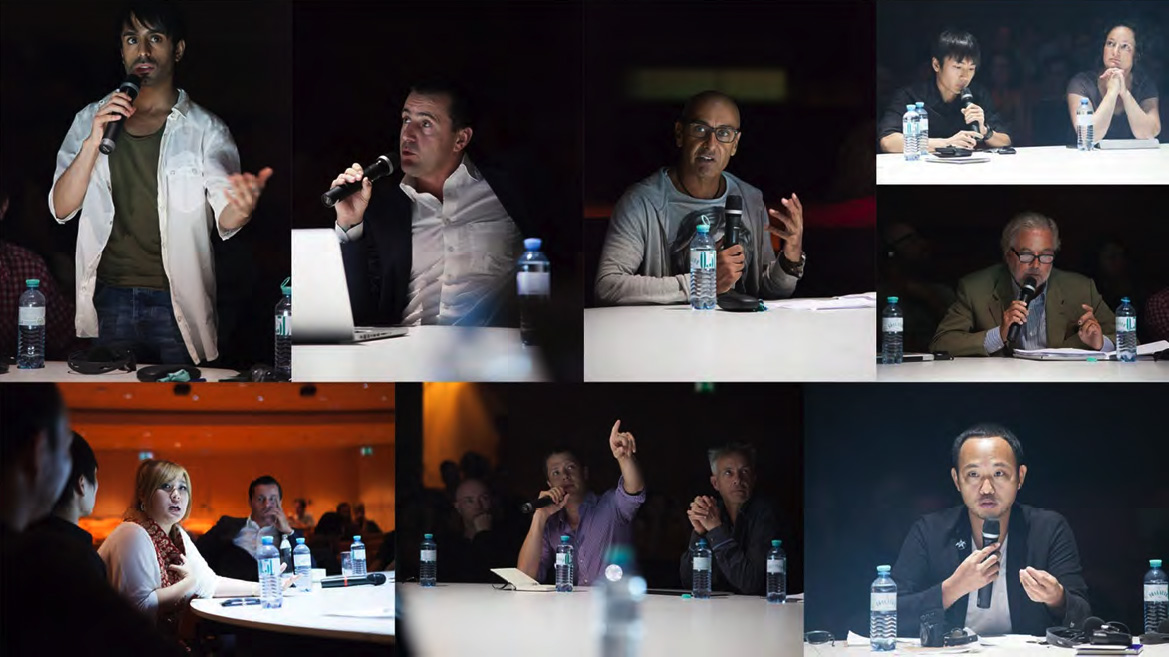
Bringing together such a diverse range of experts in an unorthodox forum labeled ‘The Future Rock Show’ was predicted to yield interesting results. Further to their briefing, many of the participants were not focusing on the future rock show per se as the intention was to illuminate the prospect of such converging disciplines on the format. Through the table discussion alone we were able to achieve this which reinforces the trans-disciplinary approach. Furthermore, several key threads for conceptualising the future rock show were generated out of this discussion. It is anticipated that these same threads can also be applied to a larger research framework about Future Live Experience. The following examples form a departure point for further investigation:
When does the future rock show occur? Is the performance only the climax of a much longer engagement? Pre-show, show, post-show.
Is the limiting format of Rock, and associated parameters, a problem that needs to be changed? Will the cross breeding of art forms with rock make totally new formats of entertainment or can it maintain the classification of rock show?
Who are the future music performers? Will the human performer become obsolete by means of robots and virtual characters which have already achieved great success? Or will they continue (or at least pretend) to perform and how can they surprise the audience?
Where is the space for the future rock show? Will it be a concert hall, inflatable theatre or completely indeterminate of physical space? Are the criteria for selection based on cultural reference and our perception of space? What will be the role of the institutions where the events can occur?
What is the real essence of the LIVE rock show? Is it the physicality – the importance of feeling, feeling others or feeling art in general? Does this physicality give the authenticity and credibility? Can this then distinguish the value criteria between distributed vs non-distributed performance? Is it important to be there or is it enough to transfer the ‘I was there’ experience through virtual means.
Why the heavy focus on the participation? Is it more of a fad because participation is cool? Or is it rather the case that it is human nature to participate/collaborate in music and has been since music’s existence? Can the answers be found equally through historical contexts? What is the role of the performer and the audience when developing valuable participation models? Do they need each other or is it more a case of the audience needing the audience?
What is the role of technology? Will it continue to have the same impact on extending the parameters of performance (amplified sound)? Are the things we are afraid of opening up new possibilities? The majority watch the event through their devices – the same devices which can be used to decipher and contextualize a networked group of individuals. Does contextualizing this experience produce more interesting and democratic expressionism? Is there a value in virtual…..tbc
CREDITS: THE FUTURE ROCK SHOW EVENT
INSPIRATIONAL PRESENTERS:
Damian Kulash (US): OK Go
Huang Yi (TW): Artist
Sven Sören Beyer (DE): Phase7
Peter Higgins (UK): Land Design Studio
Daito Manabe (JP): Artist
FM Einheit (DE): Composer / Musician
Farooq Chaudhry (UK): Producer
Chris Müller (AT): Event Producer
Yuri Suzuki (JP): Artist
Hans Hoffer (AT): Director Max Reinhardt Institut
Kazuhiko Washio (JP) : Hakuhodo Inc.
Lewis Major (AU): Dance / Choreography
Aakash Odedra (UK): Dance / Choreography
Jonathan Parsons (AU): Artistic Director ISEA 2013 & Experimenta 2014
Hideaki Ogawa (JP): Ars Electronica Futurelab
Salvatore Vanasco (IT): Media Artist
MEDIATORS:
Horst Hörtner (AT): Director Ars Electronica Futurelab
Gerfried Stocker (AT): Director Ars Electronica
COORDINATOR:
Kristefan Minski (AU): Ars Electronica Futurelab
ARTWORK – LIQUID LOG: Ars Electronica Futurelab: Horst Hörtner, Martina Mara & Veronika Pauser
ARTWORK – KAZAMIDORI: Hideaki Ogawa
TECHNICAL MANAGEMENT:
Joschi Viteka (AT)
Franziska Mucha (AT)
CREDITS: THE FUTURE ROCK SHOW PROJECT
CONCEPT: Horst Hörtner, Kristefan Minski, Hideaki Ogawa & Gerfried Stocker
TEAM: Martina Mara, Kristefan Minski, Hideaki Ogawa & Veronika Pauser
PROJECT MANAGER: Kristefan Minski
ARS ELECTRONICA FESTIVAL DIRECTOR: Martin Honzig
FESTIVAL TEAM: Franziska Mucha & Joschi Viteka
The Future Rock Show Event was sponsored by Hakuhodo
CREDITS: THE FUTURE ROCK SHOW SUMMARY REPORT
AUTHOR: Kristefan Minski
COVER PHOTO: Florian Voggeneder